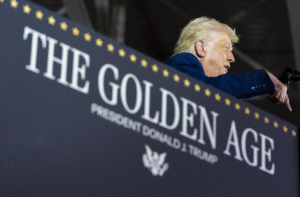Tariffs Trigger 41% Import Surge as U.S. Companies Race to Avoid Soaring Costs—this dramatic shift in trade behavior reveals how deeply tariffs are now influencing the U.S. economy, business strategies, and consumer prices.
Why Did U.S. Imports Suddenly Surge by 41%?
U.S. businesses boosted imports by 41% in early 2025 in a rush to avoid new tariffs proposed by President Trump’s administration. These tariffs—some as high as 145% on key Chinese goods—threaten to drastically raise costs on electronics, vehicles, raw materials, and essential consumer products.
Primary reason: Many companies are stockpiling products now to sidestep higher duties later.
This strategy, called “front-loading”, causes a short-term spike in trade activity but carries economic risks in the long run.
Why U.S. Companies Are Racing to Beat Tariffs
Here’s a breakdown of the factors influencing the 41% surge in imports
[Tariff-Driven Import Surge]
|
---------------------------------------------------
| | |
[New Trump Tariffs] [Fear of Inflation] [Stockpiling Strategy]
| | |
145% on Chinese goods Consumer costs rising Import early, save costs
Steel, electronics Supply chain stress Maximize margins
This decision-making pattern is especially common in retail, auto manufacturing, and electronics sectors.
What Exactly Are Businesses Importing—and Why?
Companies are importing a range of goods they believe will be costlier in Q2 and Q3 2025. The table below shows what sectors are most active:
| Industry | Top Imports | Reason for Import Surge |
|---|---|---|
| Technology | Semiconductors, displays | Avoid tariff hikes on key components |
| Retail | Apparel, electronics | Prepare for seasonal demand + tariffs |
| Automotive | Vehicle parts, steel, aluminum | Maintain inventory before price surge |
| Construction | Machinery, tools, raw materials | Insulate against future cost increases |
| Pharmaceuticals | Ingredients, packaging materials | Secure supply chain reliability |
How Is the U.S. Economy Reacting to the Import Spike?
The surge in imports helped drive the U.S. trade deficit in goods to $162 billion in March 2025, its highest level in 18 months. Because imports are subtracted from GDP, the economic consequences followed quickly.
The GDP shrank by 0.3% in Q1 2025, the first contraction since 2022.
This drop was not due to consumer weakness but largely caused by how GDP is calculated. Businesses acted rationally—but the statistical impact was negative.
What Does This Mean for the Average American?
The economic shift is already rippling into consumer life. Here’s how it’s affecting everyday Americans:
- Electronics prices could rise up to 18% by mid-year.
- Retail costs for clothing, appliances, and household items are expected to increase 10–15%.
- Auto repairs and vehicle purchases will become more expensive due to parts scarcity and costs.
Retailers and manufacturers warn that pandemic-era shortages and price volatility could return if tariffs continue to intensify.
Trump’s Tariff Strategy: A Breakdown of Its Real Impact
President Trump claims the tariffs will strengthen American industry and reduce dependence on China. Critics argue that while the long-term goals are sound, the short-term shock to supply chains and consumers is dangerous.
Some analysts warn of stagflation—a scenario with high inflation and weak growth—if tariff policy is not balanced with supply-side relief.
Who Benefits and Who Loses from the Tariff-Driven Surge?
Winners
- Shipping companies: Boost in volume
- Warehouse and logistics firms: Increased demand for storage
- Large retailers: Able to front-load at scale
Losers
- Small businesses: Can’t afford bulk imports
- Manufacturers: Rely on stable input costs
- Consumers: Face rising prices
Global Effects: Strained Trade Networks
The surge in U.S. imports caused export pressure in countries like China, Vietnam, and Mexico. Chinese exporters reported a 34% jump in shipments to the U.S. in March alone.
Ports in Asia and the West Coast of the U.S. are experiencing congestion, delayed customs clearance, and rising freight rates, threatening the stability of the global supply chain again.
Is This the Start of a Bigger Trade War?
The U.S. Chamber of Commerce and global trade analysts warn that long-term uncertainty is worse than short-term tariffs. If businesses lose trust in predictable policy, investment slows, and market volatility grows.
The White House has hinted at additional tariffs on European goods, especially in energy and automotive sectors, escalating the risk of a global trade backlash.
Conclusion: Short-Term Survival, Long-Term Risks
This 41% import surge shows how businesses adapt rapidly under policy pressure. But while the strategy might save money today, it poses broader risks for tomorrow. Economic contraction, price inflation, and disrupted supply chains are only the beginning if tensions continue to escalate.
Policymakers must balance economic protectionism with supply chain stability or risk weakening the very sectors they aim to protect.
Data Recap:
| Metric | Value (Q1 2025) |
|---|---|
| Import Growth | +41% |
| Trade Deficit (Goods) | $162 Billion |
| GDP Growth | -0.3% |
| Chinese Exports to U.S. | +34% |
[USnewsSphere.com / et.]





